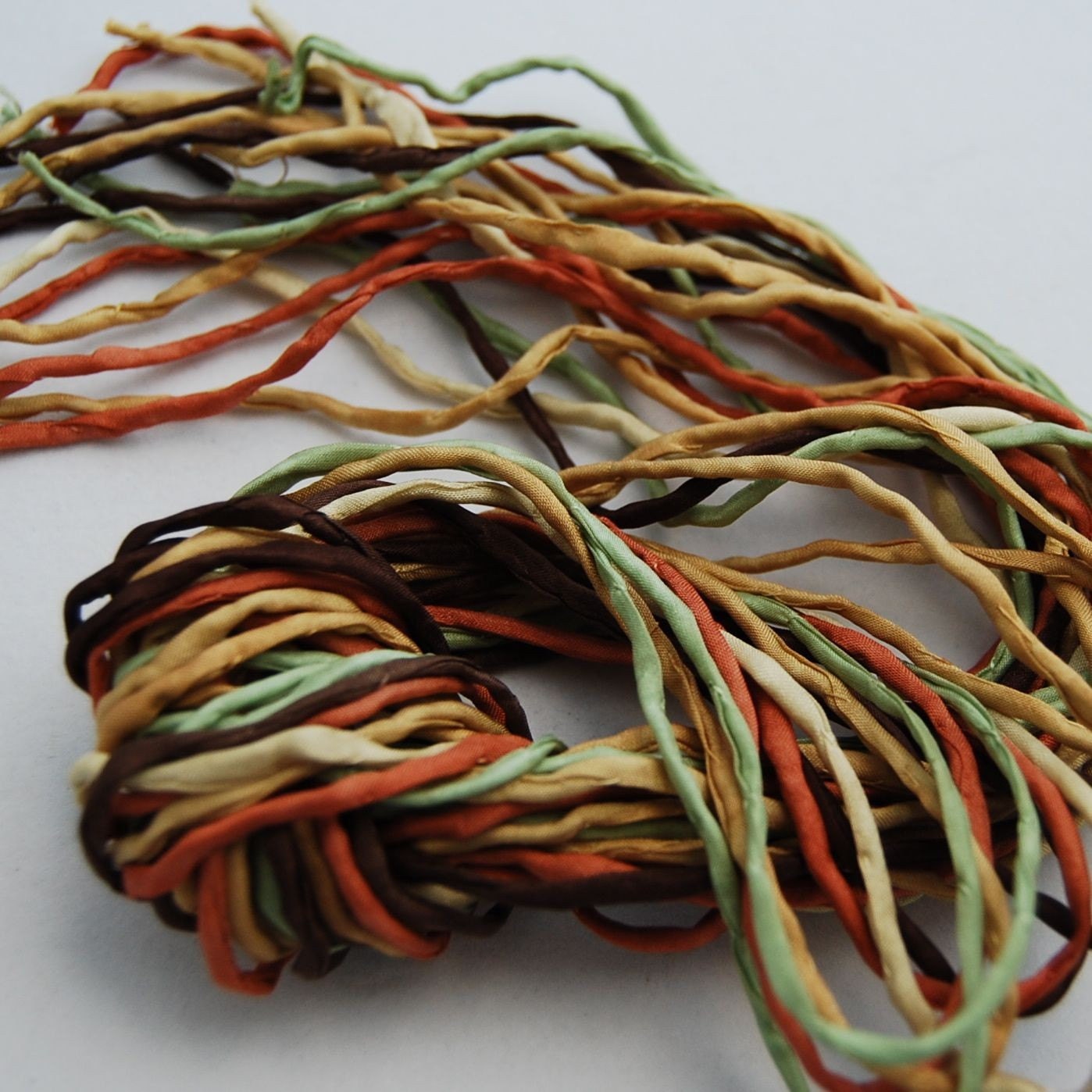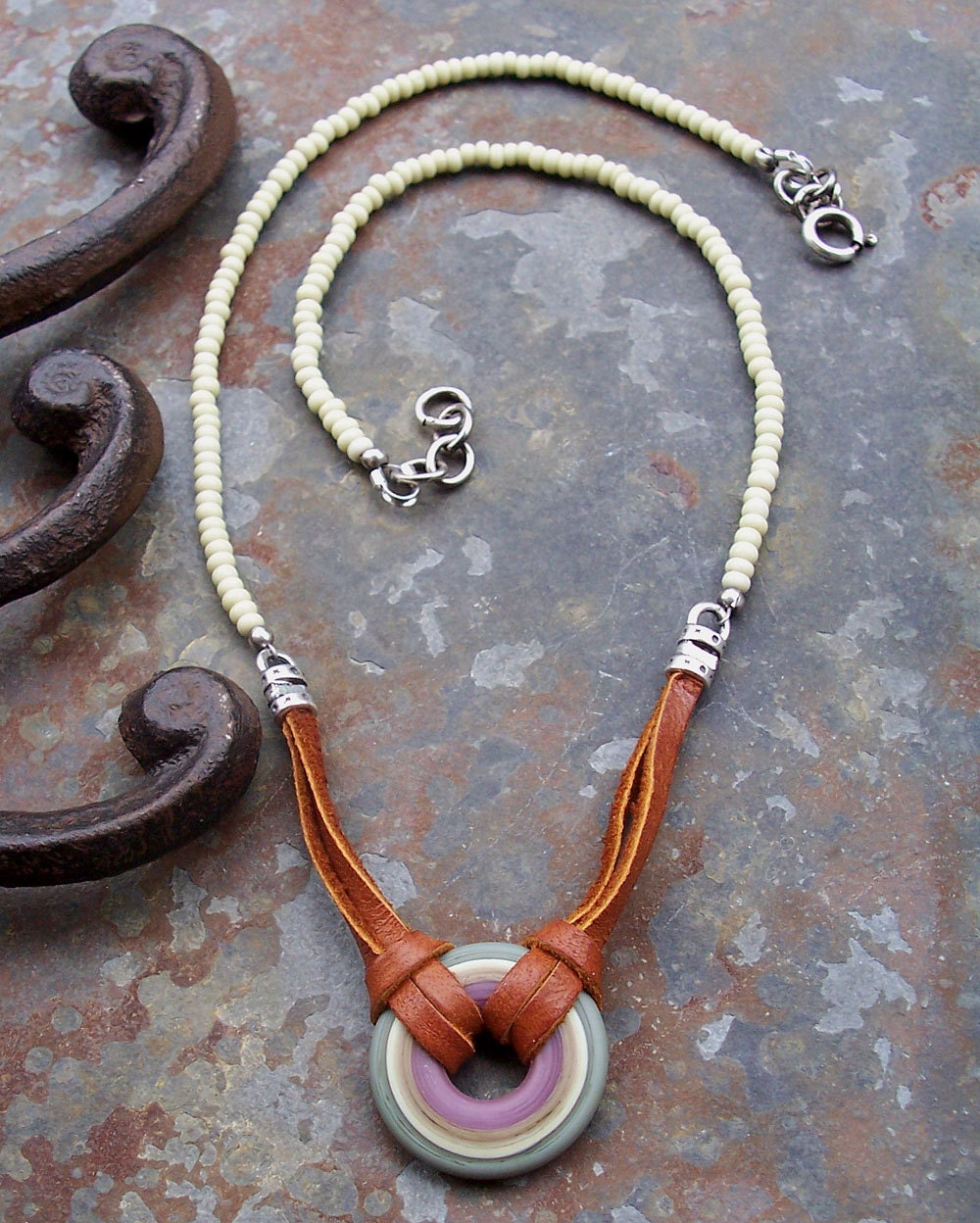Today is Part II of my post on making and using your own coil crimp ends for cording, such as leather, ribbon, and silk strings. Today we're going to talk about how to actually put the things on there and tighten them up.
As I explained in my last post, I just eyeball the cording I'm using and guess at what the inner diameter of my coil should be. I try to get it as close as possible because squeezing down an oversized coil is a huge pain.

You'll probably want to practice this with inexpensive, softer wire like copper, and leather or ribbon scraps and get the hang of it before you try it on a real live project--there is definitely a motor skill learning curve! (Trust me. There are miles of mangled wire in my wake.) You may want to practice with a thinner gauge wire, such as 18 or 20, until you get a feel for how the coil behaves when you start squeezing it tight. You may even find you like the finer wires for this project anyway, depending on your preferred style (like if you tend to make more delicate, airy pieces with finer cording). I've never actually annealed the coils (the idea just occurred to me as I was writing the last post, I should write these more often), but it seems like theoretically that could be helpful. If anyone decides to do that, let me know if it made it harder or easier to fasten them onto your cording. If you anneal, I think you definitely should hammer the loop because it might be kind of soft. And if you're using a finer gauge wire, like 18 or 20, a little gentle tapping with your chasing hammer will make that loop sturdier.
First, we'll start with a piece of leather. This is 4mm round leather cord from
LeatherCordUSA. I dab some glue (PlioBond on this case, because I'm out of GS Hypo Cement--Hypo Cement is probably a better option because it's clear but the tubes seem to dry out really fast, faster than I can use them so I never have any) on the end, eyeballing it so that the gluey section is the same length as the coil, because I don't want a bunch of gluey leather protruding from the coil. (Although you can kind of scrape the PlioBond off with your fingernail, it's sort of silicone-y).
I slide the leather into the coil, all the way to the end, so I can just see the end of the leather peeking out the end--I want to make sure the leather is all the way in there, so that I have as much grabbing surface gripping the leather as possible.
I let it sit so the glue can dry a little and adhere. If you start working with it too soon, when the glue is still kind of slippery, it wont stay put while you're trying to tighten it and you'll be frustrated. So off you go to fool around on Facebook or whatever or buy some beads you don't need and come back later...
Okay, so 20 minutes or so have passed and you're now the proud owner of three more
Jade Scott charms and it's time to tighten the coil on your leather. You can gently test the coil to see if your glue is dry enough. (I don't actually know if the glue helps, but I'm paranoid, so I use it because it makes me feel better.) You're going to squeeze the whole coil tight (not just the end), one course of wire at a time.
WARNING: this is just plain ol' tedious, muddle-through, poke/prod/mash/manipulate kind of crap. If anybody has a more systematic way of doing this that involves less kluging (geek speak, meaning: "A clumsy or inelegant solution to a problem."), I would love to know! I am totally making this shit up. (
Lesley Watt of
THEAJewellery is using these too, and they look so perfectly executed! I love the double loop she has at the end. DO SHARE, Lesley!!!). I squeeze the whole thing because I'm paranoid, like I said. (A couple of my early pieces came apart, so I'm extra aggressive now with the squeezing, and I added glue.)
I usually start squeezing at the bottom, but you could probably start anywhere. (Seriously, there is probably a neater way to do this. I mean, I walk through the puddle and then dry off my shoes, instead of going around the puddle. I instinctively choose the most inefficient, labor intensive method for virtually anything I do which I why I will always be poor.)
So let's squeeze the bottom-most course of wire first. I like bent nose pliers best for this. And then squeeze the next one up, and then the next one.
See how it's starting to turn your coil into the leaning Tower of Pisa? You're going to have to correct this as you squeeze. (This is where the "tedious crap" part of this technique comes in.) Just take your bent nose pliers, place them as pictured, and just squeeze the coils back into alignment.
Rinse and repeat. Ad nauseam. Until you've squeezed and straightened it all.
You might have to squeeze it together the other way at some point.
That very last coil at the bottom is the most important. That one in particular needs to grip the tightest. I like to try to get the very tip of that last coil to bite into the cording.
You might have to squeeze a little at the top where your loop is, to round up that last coil. Adjust the alignment of the loop as necessary with your pliers.
When I'm done squeezing, I pull enthusiastically on it, like an overexcited toddler, to make sure it's really in there tight. If you tug and tug and it's not going anywhere, it's probably good.
Don't be alarmed if your first try is messy. This is totally a motor skill thing, like throwing pots. Which I've never done. Which is why you want to practice with cheap wire and throw-away cording if you can. Practice on anything you want. Rope. Electrical cord (but not while it's plugged in). Red Vines.
When using silk ribbons or strings, it's very similar. I almost always use multiple strands of ribbon with this technique (if I'm only going to use one, it's easier to just loop it around a ring and secure with a coil, because bulk isn't a problem--I use the coil end mostly when bulk is going to be an issue.) Because I'm using multiple strands, it's hard to know for sure if I've got all the strands up in the coil, so to make sure every single strand is gripped tightly, after I stuff them in there, I pull them up through the coil and count the ends (four in the picture below) to make sure they're all through. (That probably makes no sense at all.) Then I back them out just a tad and it's ready for SQUEEZING. (I've never used this word so many times in one conversation.)
I can trim them off later with tiny scissors or even buzz cut them with my electric bead reamer (yes, more kluging.) Let's jump to the end of this one, all tightened up, and look at that:
I haven't used glue with the ribbons, because it's too hard to get it applied where it needs to be, but you could if you wanted to. (Erin Prais-Hintz suggested putting the little GS Hypo Cement needle right up in there, inside the cluster of ribbon--That sounds perfect!)
And then lastly, again, enthusiastic tugging (I like to try each strand individually, to make sure they're all tightly gripped in there:)
All good.
I am particularly fond of little nail scissors for trimming things like this. They're surprisingly effective. You can get them in the manicure section at Target or Walgreens or wherever. These are ancient but they're still sharp.
With all the manipulation, my coils end up with a lot of tool marks on them (you can see that in the very first photo at the top). I prefer to think of them as "textured." If you wanted to, you could even add some more "tool marks" with a texturing hammer and make them really special.
Happy squeezing!!






















































